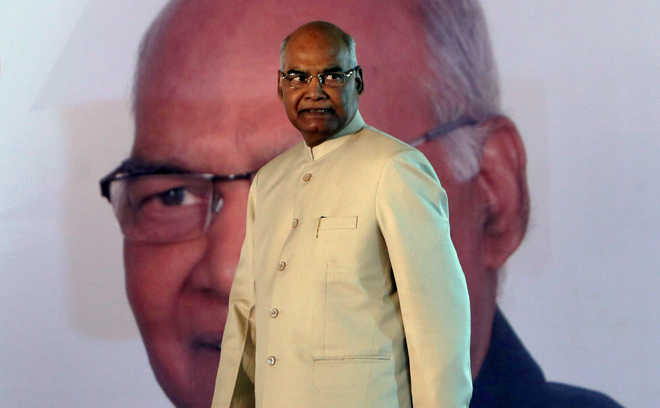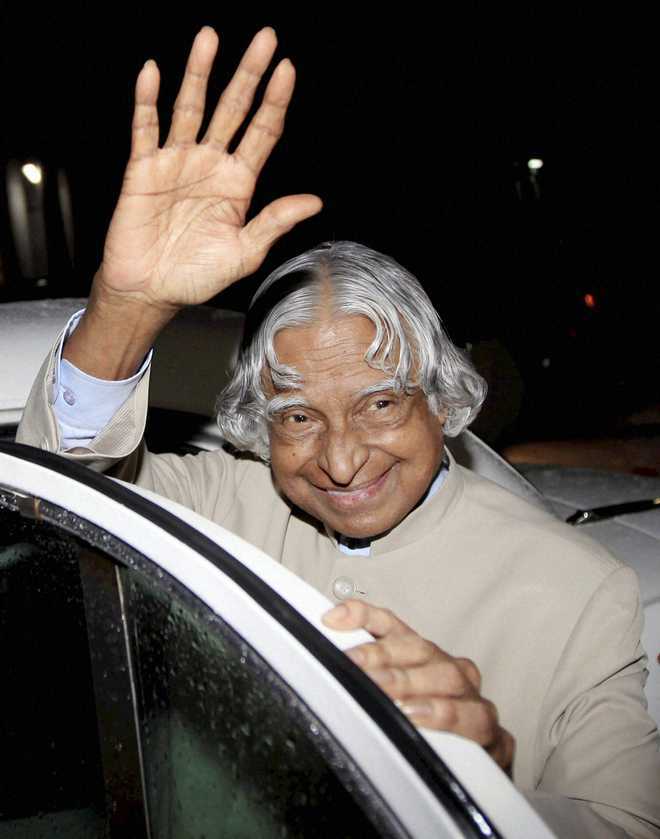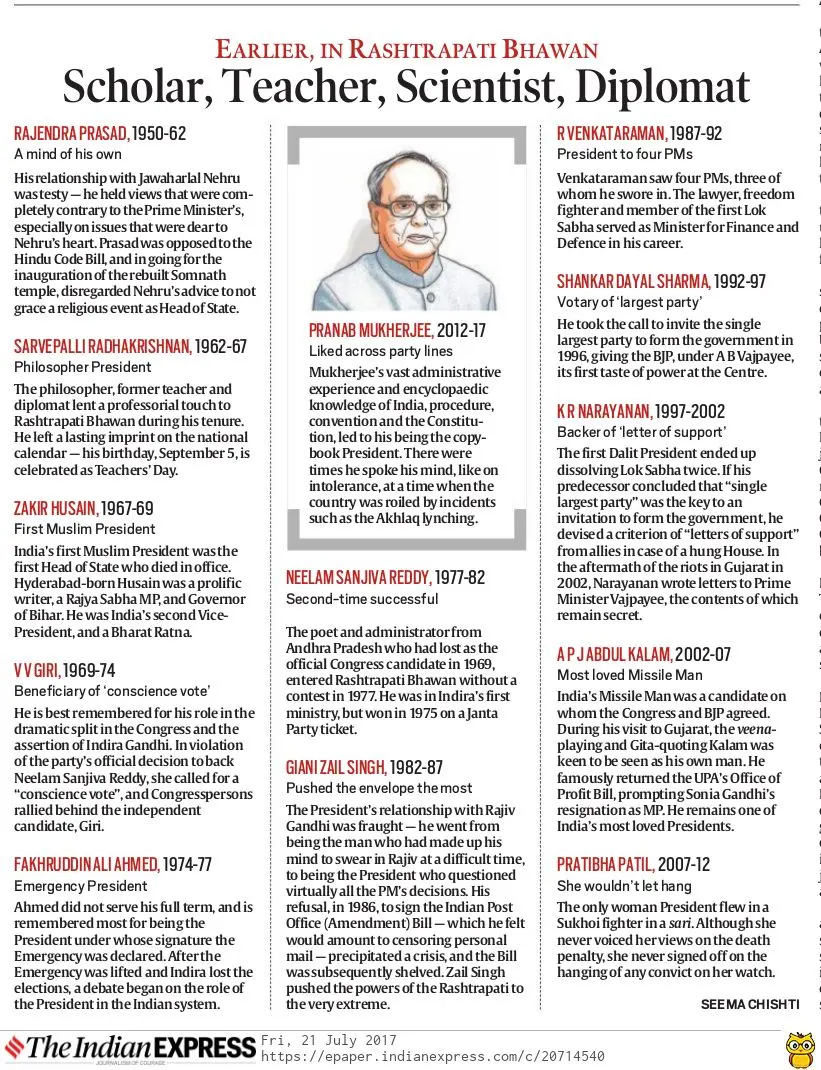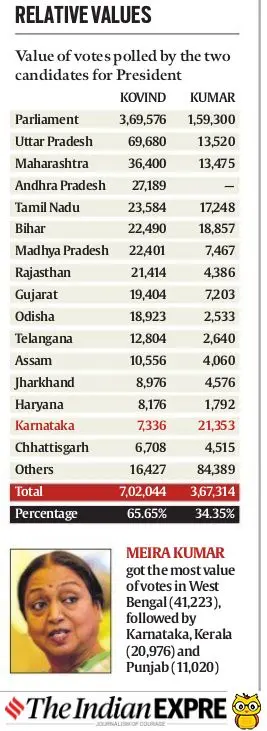Constitutional office with constitutional responsibilities

After KR Narayanan, India will have its second Dalit President in Ram Nath Kovind (71). The outcome of the electoral exercise was known well in advance and political interest was limited only to the margin of victory. It may be inappropriate to mention the caste of a President but politics has sunk so low that more than merit, qualifications, stature or suitability political decisions are guided by such extraneous factors as caste. Given the general acceptability of caste politics in the country, it did not surprise or shock too many people to see the Presidential poll being reduced to a “Dalit-vs-Dalit contest”, even though the Opposition and its representative, Meira Kumar, tried to make it look like “a battle of ideologies”. Political decisions of the BJP — be it the choice of Kovind as the Presidential candidate or Yogi Adityanath as the Uttar Pradesh Chief Minister — are taken with an eye on 2019. Kovind’s choice was an attempt to contain the anti-BJP Dalit upsurge in places like Hyderabad, Gujarat and Uttar Pradesh. Dalit politics apart, as President, Ram Nath Kovind will be measured against the standards set by one of his worthy predecessors, KR Narayanan, who he will often be compared with. Since political expediency has landed Kovind the high office, every Presidential decision would be judged by the yardstick of political neutrality. Though the President’s is mostly a ceremonial office, at times of political uncertainty during government formation or recommendations for President’s rule, Rashtrapati Bhavan plays a significant role. Any hint of political bias at such critical moments would be held against him. The nation will keenly watch how he graduates out of his political affiliations. Kovind was living in political obscurity and Narendra Modi and Amit Shah have put him on the national centre stage; indeed most Presidential candidates belong to a political party. The outgoing President, Pranab Mukherjee, was a life-long active Congressman till his election. In keeping with the demands of the august office Kovind will now have to rise above the pulls and pressures of the political class and emerge as a true Head of State.http://www.tribuneindia.com/news/editorials/president-ram-nath-kovind/439599.html
From Rajendra Prasad to missile man, take a look at previous Presidents

APJ Abdul Kalam was the first scientist to become a President in 2002. File photo
New Delhi, July 20
Ram Nath Kovind was on Thursday elected President of India. He defeated former Lok Sabha Speaker Meira Kumar to the post.The presidential election on July 17 saw close to 100 per cent polling. A total of 771 Members of Parliament and 4,109 legislators were eligible to cast votes.The two presidential nominees — National Democratic Alliance’s (NDA) Ram Nath Kovind and Opposition’s Meira Kumar — are both from the Dalit community.Here is a list of achievements of previous Raisina Hill occupants.
Rajendra Prasad (1950-1962):
Prasad was the first President of Independent India and stayed in office for the longest term of around 12 years. Post the completion of his tenure, he quit the Congress and set up new guidelines for parliamentarians which are still followed. Prasad played a major role in forming the Bihari Students Conference in 1906 and served as the president of the Constituent Assembly that drafted the Constitution of India.
Sarvepalli Radhakrishnan (1962-1967):
September 5, the birthday of Radhakrishnan, one of the most learned scholars and statesmen of the nation, is celebrated as Teacher’s Day in India. He was one of the first to receive the Bharat Ratna, in 1954, and was also the first to lead the line of five Presidents to receive the Bharat Ratna till now. Shortly before his death in 1975, he was honoured with the Templeton Prize for his work.
Dr Zakir Hussain (1967-1969):
Dr Hussain was the country’s first Muslim president, who occupied the office for the shortest period. His untimely death two years after being elected made VV Giri the first acting President of India. Dr Hussain was an avid intellectual educator and the co-founder of Jamia Millia Islamia University.
Varahagiri Venkata Giri (1969-1974):
Giri resigned two months after being appointed as the acting President of India, following the death of Dr Zakir Hussaian as he wanted to become an elected President. He was later elected as the fourth President of India in 1969. After India attained Independence from the British, VV Giri had been appointed as the High Commissioner to Ceylon. In 1957, he headed a team of prominent public personalities and academicians to establish The Indian Society of Labour Economics (ISLE) and received the highest civilian award, the Bharat Ratna, in 1975, for his contribution in the area of public affairs.
Fakhruddin Ali Ahmed (1974-1977):
Ahmed served as the President of India during the time of Emergency. He was the second Muslim to be elected as the President of India and also the second to die in office. Ahmed was awarded an honorary doctorate by the University of Pristina, in Kosovo, in 1975. In his honour, a medical college Fakhruddin Ali Ahmed Medical College has been named at Barpeta, Assam.
Neelam Sanjiva Reddy (1977-1982):
Reddy was the sixth President of India and the first to be elected unopposed and the youngest to occupy Rashtrapati Bhavan. One of the incredible feats that Reddy achieved was that he renounced residency at the Rashtrapati Bhavan and took a 70 per cent cut in his salary as a gesture toward the poor economic conditions of the masses in 1977.
Giani Zail Singh (1982-1987):
The only Sikh President of India till now, Singh also served as the Chief Minister of Punjab. He came under the scanner during Operation Blue Star, when then Prime Minister Indira Gandhi ordered the security forces to combat Jarnail Singh Bhindranwale and his armed followers in the Golden Temple, Amritsar. Since the order to the armed forces has to come directly from the President, questions were raised as to how Gandhi managed to order the Army to carry out the mission.
Ramaswamy Venkataraman (1987-1992):
As a President of India, Venkataraman had the distinction of working with four prime ministers. Before being elected as the President, Venkataraman served a stint as the Governor of the International Monetary Fund, the International Bank for Reconstruction and Development, and the Asian Development Bank. He was also among the delegates of India at the United Nations General Assembly and was also elected the President for life of the United Nations Tribunal.
Shankar Dayal Sharma (1992-1997):
Sharma earlier served as the eighth Vice-President of India and the Chief Minister of Bhopal. As the member of the Congress, he accompanied the movement against the Nawab of Bengal, who expressed desire to retain the princely state. Sharma was arrested in 1948 for leading a public agitation against the Nawab. During his tenure, Sharma rejected the mercy petitions in all 14 cases placed before him.
KR Narayanan (1997-2002):
Popularly known as KR Naranayanan, he was the first Dalit-origin President of India. Narayanan, who formerly served as a diplomat, served as India’s ambassador to China and the United States. As a President, he always explained his decisions to the nation, and brought openness and transparency in the functioning of the President. During his tenure, Narayanan dissolved the Lok Sabha twice — firstly he refused to dismiss the Kalyan Singh government in Uttar Pradesh in 1997 and a year later, the Rabri Devi government in Bihar in 1998.
APJ Abdul Kalam (2002-2007):
Known for his role in the development of India’s ballistic missile and nuclear weapons programmes, APJ Abdul Kalam was the first scientist to become a President in 2002. Kalam was affectionately known as the People’s President and also received the Bharat Ratna. During his tenure as the President of India, Kalam rejected one case and commuted a death sentence in another, while he did not decide on 23 other cases.
Pratibha Patil (2007-2012):
Patil was the first woman to become the President of India. During her tenure, she commuted death sentence in 19 cases and rejected petitions of three. She was also criticised for allegedly using government funds for taking trips overseas, often accompanied by relatives. She also made headlines for alleged acquisition of land in Pune and Maharashtra to construct her retirement home.
Pranab Mukherjee (2012-2017):
The outgoing President, Pranab Mukherjee, who served as the 13th President of India, will demit office on July 25. Before entering into politics, Mukherjee worked as a lecturer and journalist. Mukherjee is the only President who served all the major portfolios at the Centre — Foreign, Defence, Commerce and Finance — at different times in his political career. He rejected 30 cases of death sentence and commuted to life the death sentences of four convicts. During his term, he has spent a considerable amount of time promoting the need for improving standards of higher education and holding the compass to the political leadership to remain steadfast in observing Constitutional probity. In 1984, Mukherjee was voted as the Best Finance Minister in the World by the Euromoney magazine and is the only finance minister to serve the post both, in the Pre-Liberalisation and Post-Liberalisation eras. —ANI


